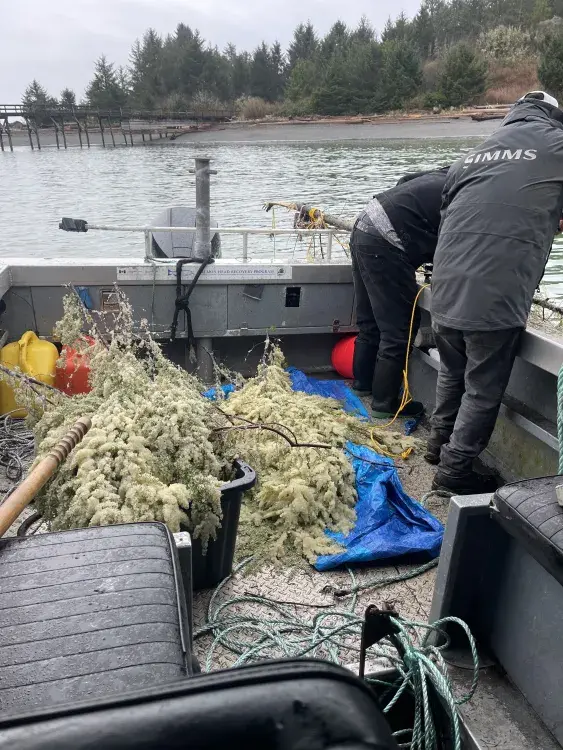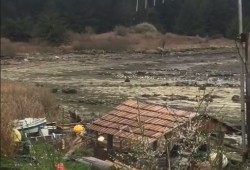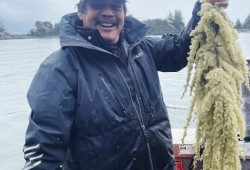This year DFO reported the largest herring spawn since the mid 1970s on the west coast of Vancouver Island, but Nuu-chah-nulth representatives will not consider a commercial fishery until they see a sustained recovery of the species.
A surge in reproduction was presented by Fisheries and Oceans Canada staff to the Nuu-chah-nulth Council of Ha’wiih Forum on Fisheries, showing an estimated spawn index of over 77,000 tonnes on Vancouver Island’s west coast in 2023. Such a figure hasn’t been recorded in the region since 1976, a time that stands as the height of herring productivity in the region since the Second World War.
As coastal waters turned a milky hue late last winter, the highest concentration of spawning on the west coast of Vancouver Island was observed by Hesquiaht Harbour, according to dive surveys conducted by DFO. It’s an indication that herring stocks are finally increasing, said Bryan Rusch, DFO’s regional pelagics coordinator, during a presentation to the Council of Ha’wiih on Oct. 25.
“The west coast stock has been slowly but steadily increasing, with a pretty large increase in the last year,” he explained.
After the last commercial fishery occurred in 2005, the calculated herring biomass west of Vancouver Island wallowed under 10,000 tonnes for several years. Conservation concerns prevented a large-scale harvest, and since 2017 the Council of Ha’wiih has agreed to not allow a regular commercial seine and gillnet fishery in the region until a sustained recovery is evident.
This year the estimated abundance of the fish was 41,200 tonnes, with 37,400 tonnes expected west of the island in 2024, according to DFO calculations. These numbers are above the previously identified abundance target that that uses a volume evident in the 1990s, an average biomass of approximately 30,000 tonnes. A different calculation than the spawn index, the herring biomass is an estimate of the volume of the fish stocks, based on scientific models.
During the fisheries meeting options were presented to Nuu-chah-nulth leaders, ranging from no herring fishery in their territorial waters to a 10 per cent harvest of the biomass. All of these scenarios meet DFO’s conservation objectives, including allowing the 1990s abundance target to be reached “with a high degree of certainty,” said Rusch.
The Council of Ha’wiih was unanimous in its opposition to opening Vancouver Island’s west coast to a commercial-scale seine and gillnet fishery.
“Our expectation is to have the support of the minister in regards to this,” said Council of Ha’wiih Chair Cliff Atleo during the meeting in late October.
“In my lifetime the herring has collapsed three times,” commented Ahousaht member Andrew Webster. “To me, we don’t want to go there again. A fourth time is not a good idea. Give it a chance.”
Concern still remains for the lifelong fisherman, who in recent years has seen his nation rely on other sources to enjoy their traditional dish of herring eggs.
“This last year was the very first year that Ahousaht didn’t have to purchase their k̓ʷaqmis,” said Webster of the popular food. “Prior to that they always had to depend on people from Bella Bella bringing it down at a huge cost. We were paying something like $15 a pound.”
The Council of Ha’wiih meeting was hosted by the Tseshaht First Nation, who have also had to purchase the traditional food from other sources.
“It costs us about $50,000 a year to give everybody just a small taste, a couple of bags each, because we’ve got a large population,” said Tseshaht Councillor Les Sam, who recalls the traditional practice of gathering herring eggs by laying branches in the water. “The very last time we had an abundance of siiḥmuu in our territory was about 1983. My late dad, my uncle Willy and quite a number other Tseshahts were down there dropping trees around our cabins.”
It’s a generational shift that Sam fears could affect younger members of his nation who have little awareness of harvesting herring roe.
“They do spawn in other territories on the coast, but not directly in ours where we used to harvest,” he said. “I feel bad for younger kids that didn’t get to feast on the siiḥmuu much like I did as a kid. I remember it well and how precious it was when we did have an abundance of siiḥmuu.”
Some Nuu-chah-nulth representatives questioned the heavy reliance on DFO’s scientific models that are used to determine the health of herring stocks. At a Council of Ha’wiih Forum early this year results of a research project by Uu-a-thluk indicated that herring could have little chance to rebuild to a sustained population due to predation by other fish and marine mammals. Hake, humpback whales and stellar sea lions are eating close to what the herring population in Nuu-chah-nulth territory can support, according to the Uu-a-thluk study, which is backed by the B.C. Salmon Restoration and Innovation Fund.
In an effort to better track the health of herring populations, DFO is introducing a new assessment model next year, a tool that was approved by the Canadian Science Secretariat in June. The new model will include the impact of spawn-on-kelp fisheries, consider herring mortality in a more realistic way and combine surface spawn surveys to the existing work conducted by divers.
The federal department plans to introduce this new tool in the Strait of Georgia next year, an area that has, for the most part, been the only location on the B.C. coast to support a large-scale commercial herring fishery in recent decades. This harvest occurs for a few weeks each spring, where boats aim to catch female herring full of eggs. This valuable roe is mostly sold to markets in Japan, while the herring are processed into feed for livestock and fish farms.
This fall DFO has drafted an Integrated Fisheries Management Plan, a document that has been sent to First Nations representatives and others with a stake in herring management. The federal department now awaits input before a final fisheries plan is made in early 2024.
“In years prior it’s basically had the decision on what the harvest approach is going to be in the draft, whereas this year it’s really going to be seeking input from people on what they think the final IFMP should look like,” said Rusch.
According to DFO research, the sustained abundance of herring stocks will directly impact the diets of Pacific salmon and a number of other animals in coastal waters. Herring accounts for 62 per cent of what chinook salmon eat and 58 per cent of the coho diet, while comprising 71 per cent of what lingcod consume and 32 per cent of the harbour seal’s diet.









